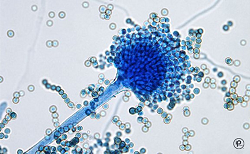Description:
UK Fungus Day
October 12th is UK Fungus Day, a chance for us to celebrate these cryptic, often microscopic, but essential organisms. Usually hidden away inside plants or in soil (or if you’re unlucky, in between your toes), fungi have largely been growing below scientists’ radars for centuries. Mycologists still don’t know anything close to the true number of fungi that exist on the planet. About a hundred thousand have been formally identified, but it’s estimated that anywhere from half a million to ten million species may exist. This dwarfs, by several orders of magnitude, how many mammals there are on Earth. And, increasingly, we’re realising quite how crucial fungi are to the functioning of our ecosystems. Head of Mycology at The Royal Botanic Gardens Kew, Bryn Dentinger, explains how valuable fungi really are.
Nobel Prizes 2014; Gauge; Genetics and Diabetes; UK Fungus Day
BBC Radio 4 2014
Medical and Patient education videos
-
Title
Description
-

Stewart Armstrong has chronic pulmonary aspergillosis and has undertaken to record a video of every day of his life for a month in order to help raise awareness of aspergillosis and how it impacts their daily lives.
These videos are interesting for a number of reasons – not least because patients often say that they don’t look unwell so many people don’t understand how serious aspergillosis is. Does Stewart look or act unwell?
See the month of vlogs in the playlist below, or go to Stewart’s YouTube page to watch more of his videos.
-

Global fungal killers and life-threatening infections
Fungi are everywhere, and a few species can cause very serious lethal infections. Fungal infections
-

This panel considers and debates one of the greatest obstacles to food security in many parts of the world: mycotoxin. Aflatoxin is a particularly dangerous mycotoxin produced predominantly by two Aspergillus fungi. It colonizes a variety of important food and feed crops both pre- and post-harvest, including groundnuts, tree nuts, maize, rice, figs and other dried foods, spices, crude vegetable oils and cocoa. Contaminated crops have significant health risks for both humans and animals, having been linked to retarded growth and development (stunting), immunosuppression and liver cancer. The aflatoxin issue has other, complex implications for food security and, by limiting farmers’ access to international markets, can lead to food waste and economic instability.
Panelists:
-John Lamb, Principal Associate, Abt Associates
-Dr. Kitty Cardwell, National Program Leader, USDA-NIFA
-Barbara Stinson, Senior Partner, Meridian Institute; Project Director, Partnership for Aflatoxin Control in Africa
-Moderator: Dr. Howard-Yana Shapiro, Chief Agricultural Officer, Mars, Incorporated -

The role of poorly maintained ventilation ductwork in spreading airborne infections is largely ignored because it is ‘out of sight out of mind’, but recent analysis by healthcare professionals confirms that the risks are increasing.
Ghasson Shabha will identify particular threats in healthcare facilities from dirty ductwork. He also points out that fewer than 5% of building air-conditioning systems have been inspected despite regulations making this mandatory. Dr Shabha will look at how planned cleaning strategies can reduce risks and how hospitals can use 3D building information modelling software to identify ‘infection hotspots’.
The healthcare environment can be described as a reservoir for potentially infective agents which can spread unpredictably in a whole array of ways particularly in ventilation and air-conditioning systems making it difficult to effectively control and manage, for those seeking timely information about the patterns of cross-infection. The severity of the problem has been highlighted extensively over the past decade, as part of wider umbrella of what was known as health care acquired infections (HCAIs). Airborne transmission extends over a wide spectrum, and includes many prevalent agents, inter alia Mycobacterium tuberculosis (TB),nosocomial MRSA, Aspergillus fumigatus, Serratia marcescens, norovirus, and other airborne infection.
Dr Shabha was speaking live from Birmingham and this CIBSE ASHRAE Group (cibseashrae.org) webinar was co-sponsored by the B&ES Ventilation Hygiene Group and the Institute of Healthcare Engineering and Estate Management (IHEEM).
-

Oliphant Science Awards – Year 1 project by Haruki Kurioka, Aleksa Novakovic and Bogdan Novakovic (St Andrew’s Primary School, Adelaide)
Food that we consume daily is rich in good bacteria and fungi. Yogurt, Yakult and Natto (fermented soybeans) are rich in bacteria. Cheeses (e.g. Brie & Blue cheese) and Koji contain fungi Penicillium and Aspergillus, respectively. Many Japanese and continental seasonings and dishes can be prepared with those products. Many kids and their parents don’t know much about good bacteria and fungi. First year students are here to tell us their story. Enjoy it!





